
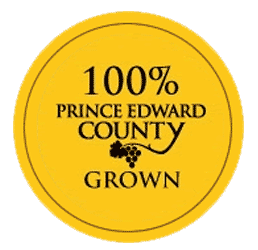
Prince Edward County, Full steam ahead.
...the region has hit the ground running. In 2000 they had a solitary winery; today they have a dozen with more planned.
by
Tony Aspler
June 17, 2005
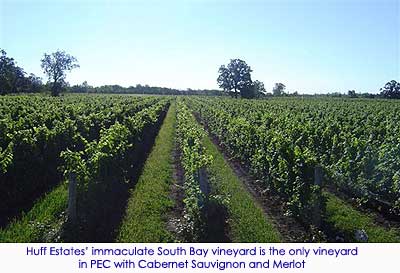
You might easily miss Prince Edward County altogether if you drive that doze-inducing stretch of the QEW from Toronto to Kingston. You have to turn off the highway onto route 33, or if you miss it route 62, and within twenty minutes you’ll find yourself in Canada’s newest wine region.
If the winemakers of Prince Edward County play their cards right they could become a real player – they could be Sonoma to Niagara’s Napa. (California’s Napa Valley is virtually all vineyards with designer wineries cheek by jowl. Sonoma is down home country with dairy farms and wheat fields punctuating the landscape and wineries that look like somebody’s old horse barn.) The County, as those who live there call it, has the same bucolic and rustic charm as Sonoma and vineyard acreage there is now hot property - in spite of the difficulties in keeping young vineyards alive through their hard winters.
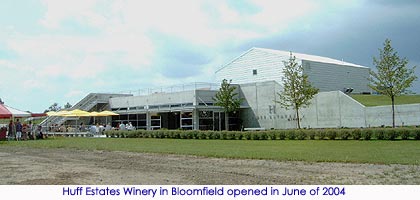 Certainly the region has hit the ground running. In 2000 they had a solitary winery; today they have a dozen with more planned. More than $30,000,000 has already been invested in vineyards and winery facilities. PEC has yet to get the official blessing of the VQA as a designated viticultural area but it has in place the infrastructure for a successful wine tourism experience even before they had a critical mass of wineries. They already have a wine route in place, a ‘Taste Trail,’ good restaurants and an event they call ‘The Taste of the County.’ And that’s what you need to sell your wine – getting consumers to visit you, spend the day touring wineries and taking home your product.
Certainly the region has hit the ground running. In 2000 they had a solitary winery; today they have a dozen with more planned. More than $30,000,000 has already been invested in vineyards and winery facilities. PEC has yet to get the official blessing of the VQA as a designated viticultural area but it has in place the infrastructure for a successful wine tourism experience even before they had a critical mass of wineries. They already have a wine route in place, a ‘Taste Trail,’ good restaurants and an event they call ‘The Taste of the County.’ And that’s what you need to sell your wine – getting consumers to visit you, spend the day touring wineries and taking home your product.
Prince Edward County was settled by Empire Loyalists who fled the American Revolution. This first wave of immigrants cleared the land and planted barley and hops. The field stone farm houses and the solid brick houses of Picton, Wellington and Bloomfield are a testament to the wealth of those industrious nineteenth century farmers who supplied American breweries with hops and malted barley.
With the introduction of tariffs against these products in 1880 the local farmers turned to green peas and other vegetables suitable for canning. A thriving cheese industry developed since the area could sustain animal feed crops as well as fruit orchards. Even grapes were grown. In the1870s there was a winery in Hillier whose wines were good enough to take a gold medal at the Centennial Exposition in Philadelphia.
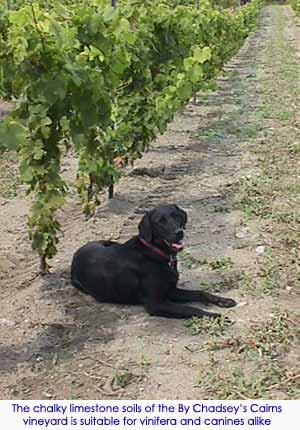 Prince Edward County might seem an unlikely wine region – an island, formerly a peninsula that jutted out into Lake Ontario mid way between Toronto and Kingston. The dredging of the eight-kilometre Murray Canal between 1882 and 1889 effectively cut off the County from the mainland, creating an island of 250,000 acres with an estimated 800 kilometres of shore line. The land here is basically a large limestone plateau rising to its highest point of 150 meters above sea level. (The presence of upper bedrock limestone soil has attracted wine growers who seek to grow the oenologist’s Holy Grail – Pinot Noir.) The limestone, threaded with shale and clay, makes for good drainage. Much of the county has a shallow soil depth before you reach bedrock; but relatively low rainfall coupled with the ameliorating effects of the Bay of Quinte and Lake Ontario make it ideal land for growing orchard fruits, tomatoes, corn and peas – and since 1993 when Ed Neuser planted his first Vidal vineyard in Waupoos, grapes for wine.
Prince Edward County might seem an unlikely wine region – an island, formerly a peninsula that jutted out into Lake Ontario mid way between Toronto and Kingston. The dredging of the eight-kilometre Murray Canal between 1882 and 1889 effectively cut off the County from the mainland, creating an island of 250,000 acres with an estimated 800 kilometres of shore line. The land here is basically a large limestone plateau rising to its highest point of 150 meters above sea level. (The presence of upper bedrock limestone soil has attracted wine growers who seek to grow the oenologist’s Holy Grail – Pinot Noir.) The limestone, threaded with shale and clay, makes for good drainage. Much of the county has a shallow soil depth before you reach bedrock; but relatively low rainfall coupled with the ameliorating effects of the Bay of Quinte and Lake Ontario make it ideal land for growing orchard fruits, tomatoes, corn and peas – and since 1993 when Ed Neuser planted his first Vidal vineyard in Waupoos, grapes for wine.
Currently there are a dozen operating wineries in the County and some 550 acres of vineyards. The major cluster of wineries is in Hillier Township where the surface gravely clay-loam soil, reddish brown in colour, is high in limestone fragments and well drained as a result.
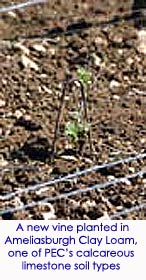 Grapes can grow here because of the moderating effect of the large bodies of water that surround the ‘island’ even if the temperature is on average five degrees (Celsius) lower than that of the Niagara Peninsula. The last spring frost can be as late as mid-May and the first frost in mid-October giving PEC a slightly shorter growing season that Ontario’s other viticultural regions. Winter is the enemy here and to protect the vines against polar temperatures the growers have to bury their vines. They use a trellis system that allows them to lower the bottom wire so that they can ‘hill’ up by back-hoeing to cover next year’s canes with earth. In the spring they uncover them, a laborious and difficult procedure but this method allows them to save at least 50 per cent of their buds.
Grapes can grow here because of the moderating effect of the large bodies of water that surround the ‘island’ even if the temperature is on average five degrees (Celsius) lower than that of the Niagara Peninsula. The last spring frost can be as late as mid-May and the first frost in mid-October giving PEC a slightly shorter growing season that Ontario’s other viticultural regions. Winter is the enemy here and to protect the vines against polar temperatures the growers have to bury their vines. They use a trellis system that allows them to lower the bottom wire so that they can ‘hill’ up by back-hoeing to cover next year’s canes with earth. In the spring they uncover them, a laborious and difficult procedure but this method allows them to save at least 50 per cent of their buds.
The County has attracted influential patrons who enjoy the collegiality of pioneering a new wine region. Winemaker Debra Paskus, chef Jamie Kennedy, Opimian Society’s General Manager John Sambrook, Imax filmmaker James Lahti and TV producer Seaton McLean and his wife, actress Sonja Smits are just some of the personalities who have been attracted to the region.
And what of the wines? Many of the wineries are still sourcing their grapes from Niagara as their vineyards mature but James Lahti’s Long Dog label is already producing stellar Pinot Gris, Chardonnay and Pinot Noir from his own grapes. The Grange of Prince Edward won a bronze medal at the 2005 Ontario Wine Awards for their home-grown Gamay Noir 2003. Huff Estate, a stunningly modern winery with a $6 million investment and a young French winemaker, will soon be making waves. Deborah Paskus is producing some elegant Pinot Noir and Chardonnay at Closson Chase and so is Norm Hardie at his eponymous winery.
So stay tuned. I predict that Prince Edward County will produce the best Pinot Noir in Canada.












